Antinol® Latest Studies
Sorted by recent
 Filter Studies by Smart Tags
Filter Studies by Smart Tags
Bone & JointCardiovascularCase Study & ProceedingCatDogEAB 277™EfficacyExotic PetImmunologyNeuro & BehaviorOphthalmologyOralRabbitRenalRespiratoryRodentSafetySkinUTI
Smart Search
Use of PCSO-524® Combined with Surgical Treatment of Patellar luxation in Dogs

Five dogs with bilateral patellar luxation were presented at the Small Animal Hospital of Faculty of Veterinary Medicine, Chulalongkorn University.
Four dogs had grade 2, 3, and 4 medial patellar luxation in 3, 3, and 2 stifle joints, respectively. One dog had grade 3 bilateral lateral patellar luxation that had recurrent patellar luxation of left stifle joint for 6 months after previous surgery. All dogs had surgical treatment to re-align and stabilize extensor mechanism in the normal position.
The dogs received anti-inflammatory drug and PCSO-524® in combination with rehabilitation to restore normal limb function and muscle mass postoperatively. All dogs achieved good outcomes when compared with pre-operation. Range of motion was normal in all dogs and the patellae were in the normal position.
However, one stifle with previous reluxation and severe osteoarthritis had slightly crepitation when flexed and extended the stifle joint. Patellar luxation causes abnormal wear of the patella and trochlear ridges leading to lameness, muscle pain, and osteoarthritis.
The treatment focuses on stabilization of the stifle joint and restore limb function. Surgical treatment is recommended in most cases. Rehabilitation provides strengthen muscle, improves normal joint function, enhanceslimb function, and prevents complications.
Despite successful treatment for correcting patellar luxation, osteoarthritis remains occurrence in most cases.
Therefore, use of anti-inflammatory supplement such as PCSO-524® is important for long-term management with less side effect and safety for long-term use when compared with non-steroidal anti-inflammatory drugs.

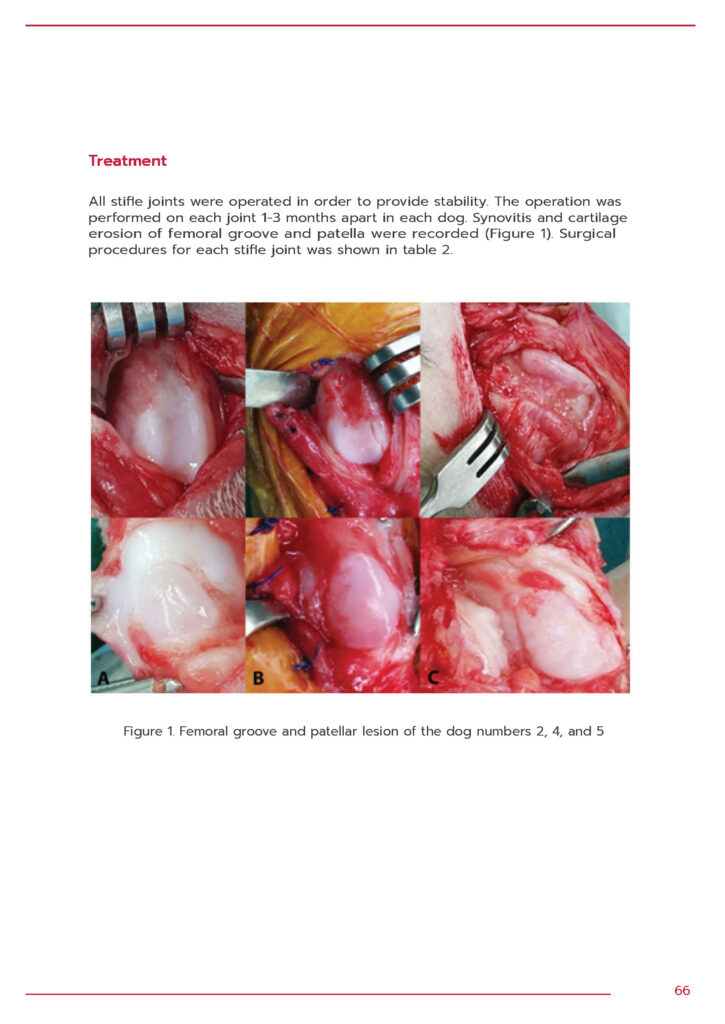
Efficacy of PCSO-524® and prednisolone combination treatment for neck pain in Chihuahua dog with Chiari-like malformation and syringomyelia

A 18-month-old male intact chihuahua presented with recurrent neck pain within 3 months after stop using prednisolone.
Upon physical and neurological examination, dog displayed pain and neck stiffness without neurological deficits. Radiographic findings of cervical spine was normal.
The dog was treated with prednisolone to relieve pain and inflammation and showed improvement of clinical signs. However, the recurrence occurred in 7 months with more severity. Magnetic resonance
imaging (MRI) demonstrated Chiari-like malformation and syringomyelia at C2-C4 and C7-T1 region.
PCSO-524® (VetzPetz Antinol®) was administered in combination with prednisolone and gabapentin. The clinical signs improved in 2 weeks so prednisolone was gradually reduced until discontinued but dose of PCSO-524® remained constantly. The dog was able to recover from neck pain and continued life activities as normal.
Long-term supplement of PCSO-524® (VetzPetz Antinol®) was effective for reducing inflammation of spinal cord in dog suffered from neck pain caused by syringomyelia.


Use of PCSO-524® for Treatment of Spine Fracture in Conjunction with Pedicle Screw-Rod Fixation (PSRF)

An intact male mixed breed dog aged 2 years engaged in a fight with several dogs resulting in disable of hind limbs and loss control of elimination. Physical and radiographic examination showed fracture and luxation of the 7th lumbar vertebrae. Spinal cord injury (SCI) was also found and the fracture was identified as the cause. The spinal cord trauma could occur since the incident and was left for more than 2 weeks.
Pedicle screw-rod fixation (PSRF) was operated to fix the vertebral column. After the second operation, it was suspected that there was remain of inflammatory cytokines that probably increased after the operation. Anti-inflammatory medication for prohibition of inflammatory cytokines synthesis was essential but its adverse effect must be concerned. The study therefore used holistic treatment including PSRF, non-steroidal drug and PCSO-524® anti-inflammatory extract, in conjunction with physical therapy.
Follow-up examination on neurological system, walking, and urinary system showed promising result. The neurological system was restored, and adverse effect of long-term use had not been found.
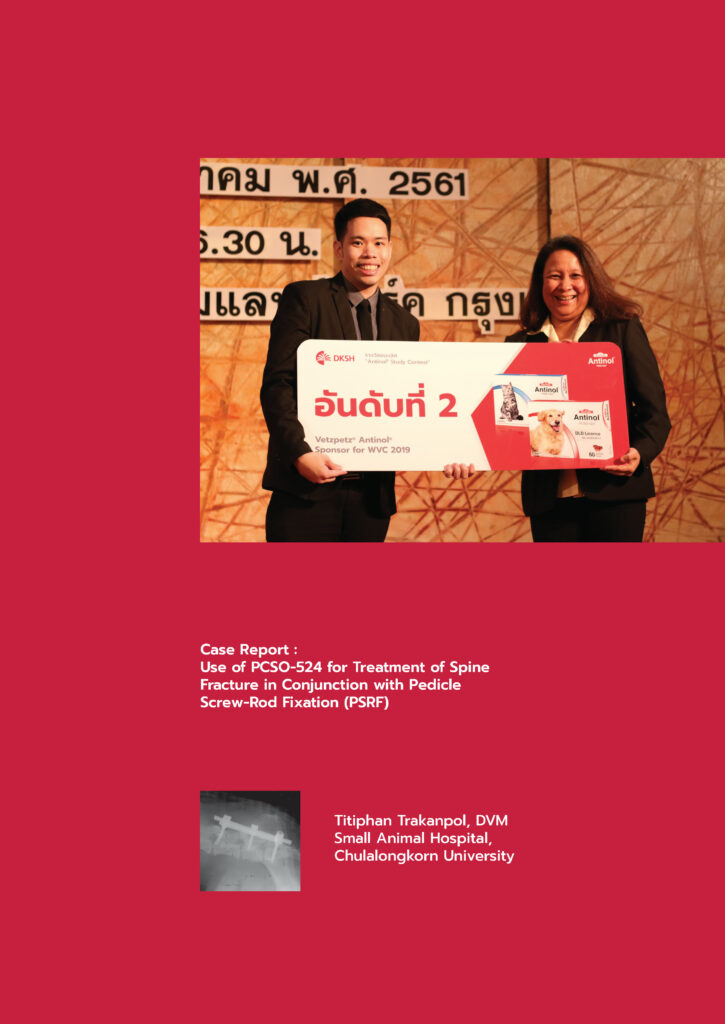

The Trial Treatment of Feline Osteoarthritis in an Eleven-Year-Old Cat

A domestic short hair cat aged 11 years was taken to the hospital due to shaking and weakened hind legs. The cat could not perform high jump for 1 month.
Preliminary diagnosis included early stage of osteoarthritis of left hip and capsulitis.
Pain killers, NSAIDs and gabapentin, were administered but the response was not satisfied. Therefore, multimodal treatment program was initiated. Physical therapy using electrical stimulation and laser beam class 4 in conjunction with PCSO-524® were used. Measurement of joint movement angle (active range of motion; active ROM) in 2 dimensions using Kinovea program was conducted for follow up.
The study found increased active ROM and decreased lameness score after the treatment.
The owner described that the cat showed less isolation behavior and was able to perform vertical jump again. Overall quality of the cat’s life was improved.


Use of PCSO-524® (Antinol)® for treatment of Obsessive-Compulsive Disorders (OCD) in Domestic Short Hair Cat

A 3 years old domestic short hair cat had shown behavioral disorder after castration 4 months ago.
The clinical signs were consistent with obsessive-compulsive disorders (OCD).
Pathological examination found edema of epidermis andinfiltration of mature mast cells in hair follicle. Treatment with PCSO-524® (Antinol)® for 180 days had shown that the misbehavior was improved due to decreased pain and skin inflammation. Healthier coat and skin appearance was noticed after 30 consecutive days of PCSO-524® (Antinol®) intake. Pathological follow-up showed less inflammation of epidermis and decreased mast cells infiltration.
It was shown that PCSO-524® (Antinol®) could reduce pain and inflammation that caused anxiety and consequently OCD in cats. Additional effects included antihistamine, antiallergy, and skin neurishing.

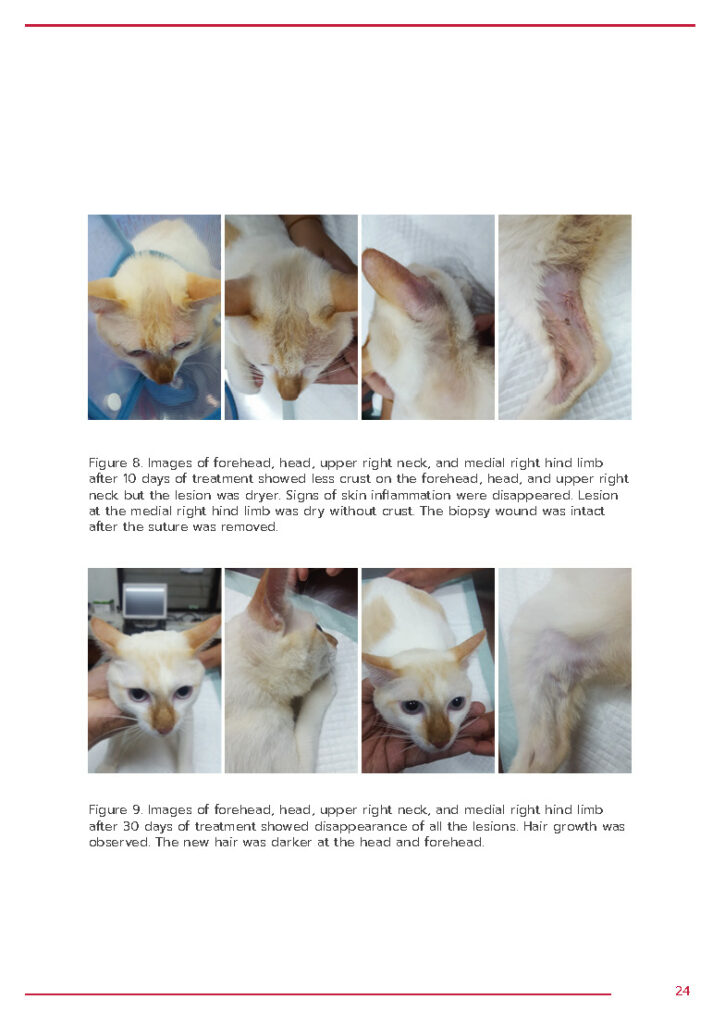
Use of PCSO-524® (Antinol®) for Treatment of Nervous Disorder Caused by Car Accident and Hip Osteoarthritis in Geriatric Cats

Male castrated Persian cat aged 12 years was injured at the rear body in an automobile accident causing paralysis of the hind limbs.
X-ray examination found luxation of both pelvic joints and osteoarthritis of hip joint. Nervous disorder of the hind limbs was diagnosed from the absence of the motor and deep pain sensory impulse. MRI examination found no spinal cord damage.
The treatment included electrical stimulation at the hind limb muscle in combination with long-term administration of PCSO-524® (Antinol®).
The hind limbs were functional normally at the end of the treatment and blood chemistry examination at 32 weeks after the treatment showed normal liver and kidney indicators.


Effects of PCSO-524® (Antinol®) Supplementation during 12 Months Follow-up in 2 Cats with Cystitis and Chronic Renal Disease

Two female cats, spayed, lived in the same house, aged 17 years weighted 2.2 kg and 10 years 4.4 kg, were having chronic renal failure and concurrent cystitis.
Both cats were treated with fluid therapy intravenously in the early period and later subcutaneously. The diet was changed to diet formulated for cats with renal failure (Hill’s Prescription diet k/d) for both cats. Avastamine (RenAvastTM) 1 capsule bid for 1 month, Cystaid® cat (Acetyl 0-Glucosamine: NAG125 mg) l capsule bid for 1 month, and PCSO-524® (Vetz Petz Antinol®) 1 capsule sid continuously were prescribed for the first cat. The second cat received only PCSO-524® (Vetz Petz Antinol®) 1 capsule sid continuously.
The treatment results showed general health improvement, weight gain (2.6 kg and 5.1 kg in the first and second cat, respectively), less hair loss, decreased degree of polydipsia and polyuria, and improvement of blood parameters.
No adverse effect of the continuous treatment was found after 18 and 13 months in the first and second cat, respectively.


A Study of Efficacy and Safety
of PCSO-524® (Antinol®) in Treatment of Medial Patellar Luxation and Cranial Cruciate Ligament Rupture in a Yorkshire Terrier Dog

Male Yorkshire terrier dog aged 7 years weight 2.5 kg suffered from lameness of left Hind limb.
Examination found medial patellar luxation of grade 3 and chronic cranial cruciate ligament rupture.
PCSO-524® (Antinol®) 100 mg per day, double size of recommended dose for dogs weighed less than 20kg, was prescribed.
Examination of lameness score and pain on palpation showed improvement after PCSO-524® (Antinol®) treatment. Radiographic images taken before and after 45 days treatment with PCSO-524® (Antinol®) did not find progress of the lesion.
Hematological and biochemistry parameters after 45 days treatment with PCSO-524® (Antinol®) indicated that the medication was safe to use.
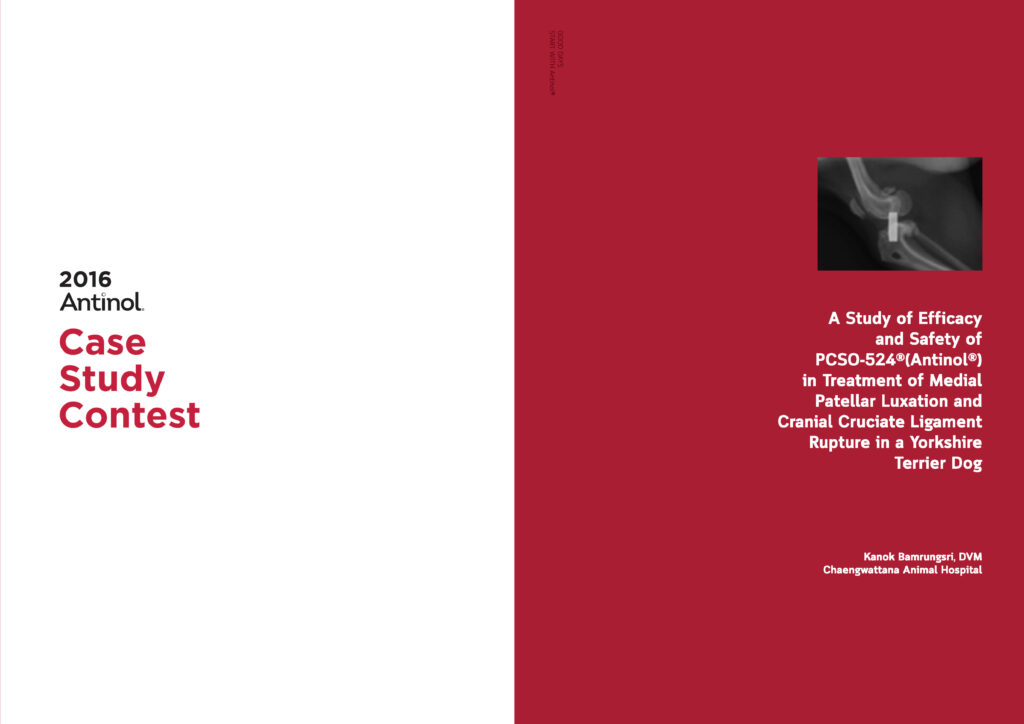
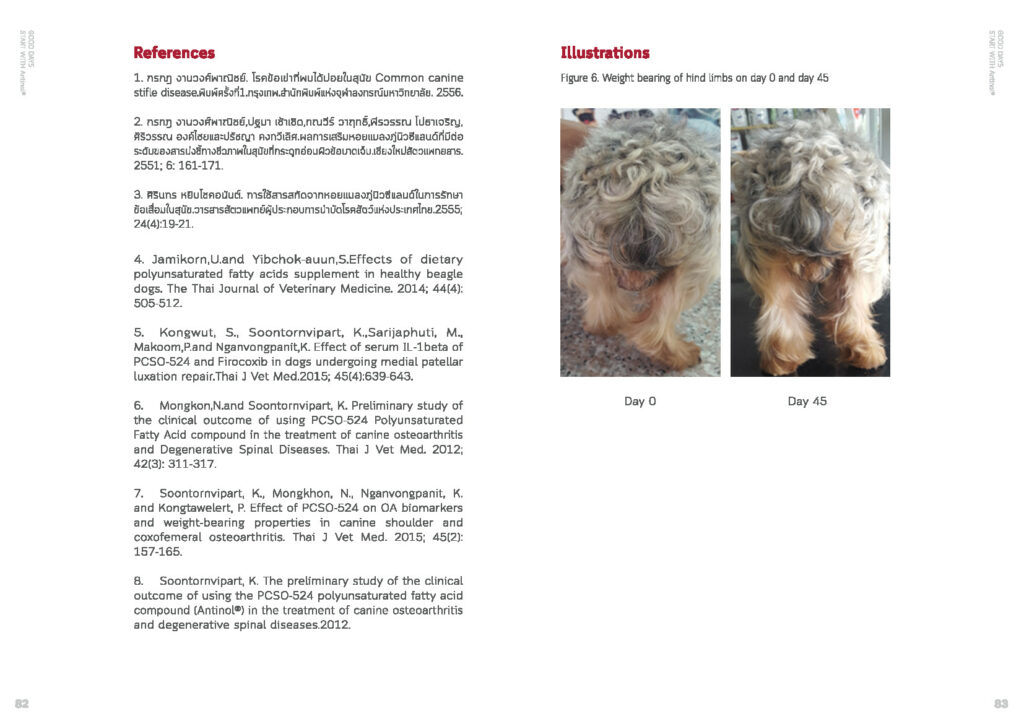
The Treatment of Medial Coronoid Disease in a Seven Months Old Labrador Retriever

Labrador retriever dog aged 7 months with history of right forelimb pain for 1 month was diagnosed as Medial Coronoid Disease (MCD) on both sides.
Radiographic and Computed Tomography (CT) examinations found subtrochlear sclerosis on left elbow. Arthrotomy was operated on the dog using subtotal coronoid ostectomy technique on the medial side of both elbows. Long-term treatment included physical rehabilitation, and nutrition therapy including administration of PCSO-524® and glucosamine/chondroitin sulfate. The dog was followed-up for 6 months for orthopedic examination and assessment by force plate gait analysis.
Two months after the operation, right forelimb could bear body weight, however left forelimb was still lame with lameness score of 1/4. Comparison of radiographic image showed that the left and right elbow was affected from moderate and mild osteoarthritis, respectively. Treatment success for MCD depends on early and accurate detection of the disease and appropriate treatment plan.
Multimodal plan consisting of surgical treatment, medication, nutrition therapy and physical rehabilitation, is proposed.
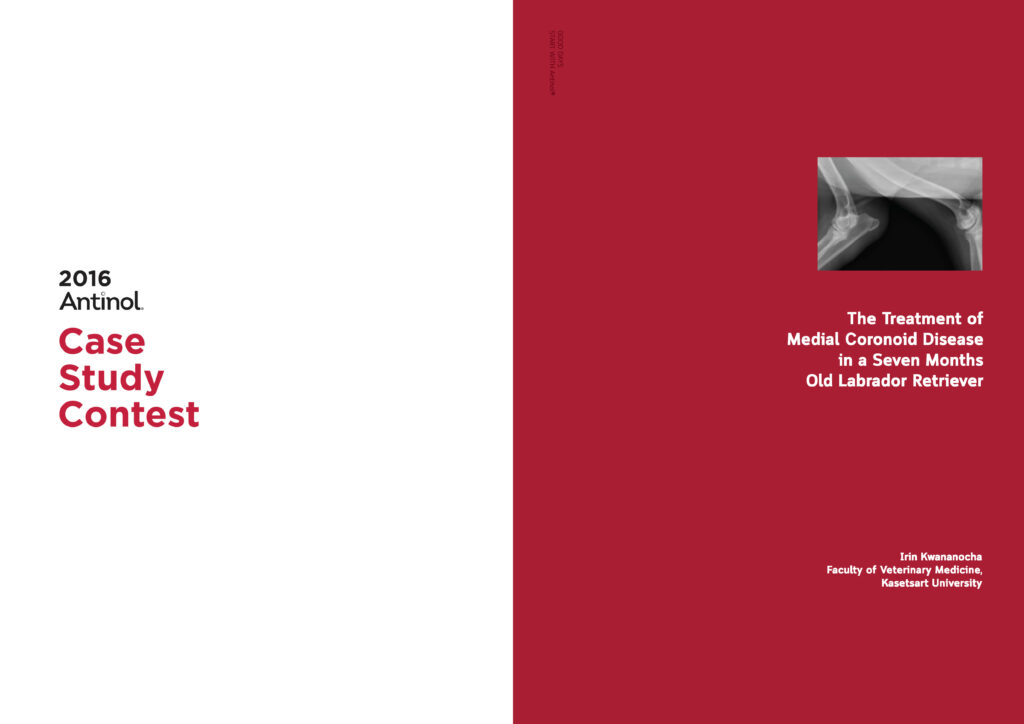

Effects of PCSO-524® on Treatment of Cranial Cruciate Ligament Rupture in Dogs after Tibial Plateau Leveling Osteotomy (TPLO) and Physical Rehabilitation

Male Labrador Retriever dog aged 3 years was suffering from left hind limb pain.
Hematological parameters were normal. Radiographic image showed swollen left stifle joint and mild osteoarthritis. Cranial cruciate ligament rupture was diagnosed.
Firocoxib 5 mg/kg sid for 2 weeks and 2 capsules of ANTINOL ® bid for 1 month were prescribed.
Tibial Plateau Leveling Osteotomy (TPLO) was operated on the dog. Post operation care included Firocoxib 5 mg/kg sid for 2 weeks and 2 capsules of ANTINOL ® bid in combination with physical rehabilitation using laser stimulation and later exercise therapy was added. Clinical signs were improved as indicated by lameness score, muscle mass and range of motion.
Five months after the operation, the dog expressed signs of right hind limb pain and radiographic image showed swollen right stifle joint and mild osteoarthritis of left stifle joint. Partial tear of cranial cruciate ligament was diagnosed. The dog was treated for thrombocytopenia until recovered before Tibial Plateau Leveling Osteotomy (TPLO) was operated on the right knee 3 months later. Radiographic examination post operation showed increased inflammation of both stifle joints.
Surgical treatment was used in combination with medication which included NSAIDs during the first 2 weeks post operation, ANTINOL®, and physical rehabilitation in order to reduce pain and inflammation. The treatment gave satisfactory results. The dog was able to use its legs without lameness, muscle was stronger, stifle angle was better and general health was improved.
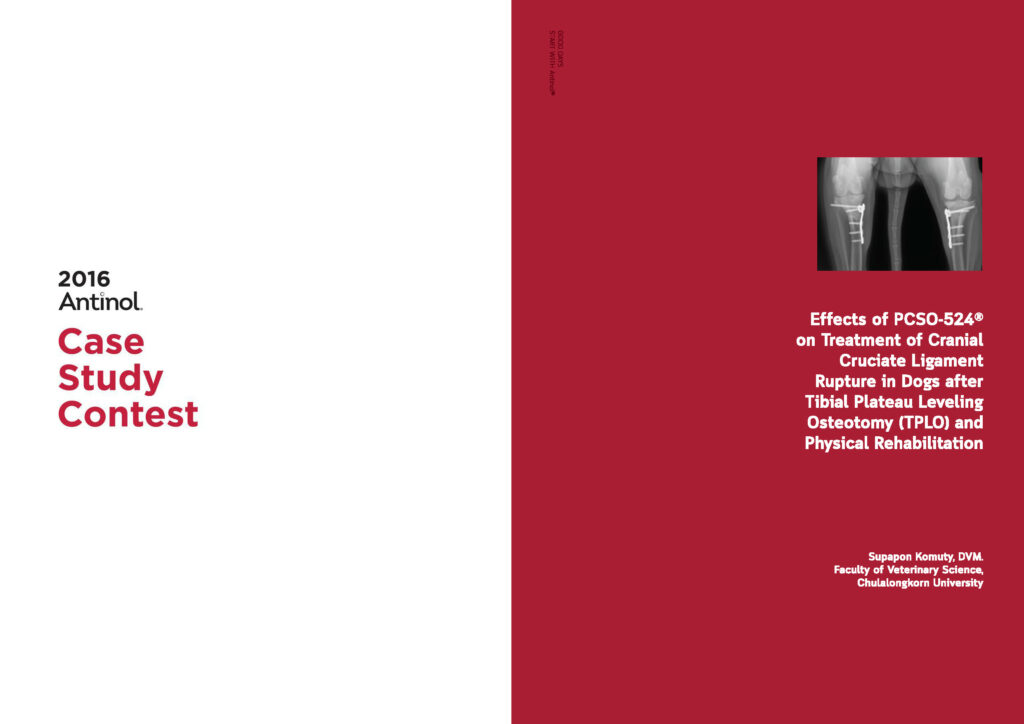
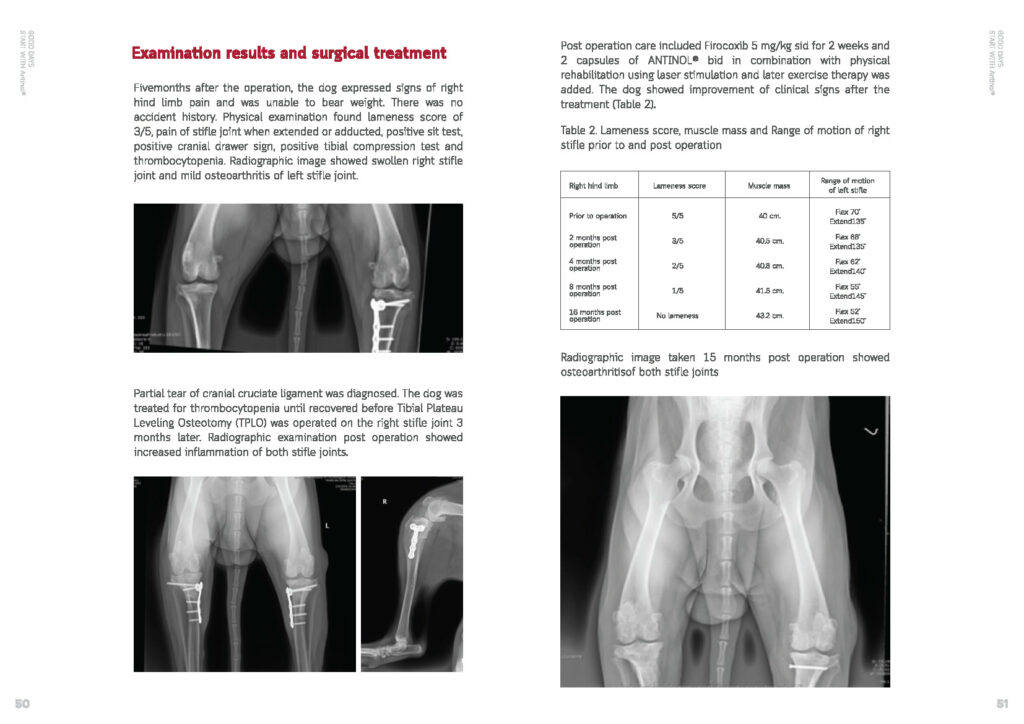
Updated Study Topics
New researches and publications related to PCSO-524® and its result in clnical test submitted by veterinarians on the global conferences every year and the data keeps growing with more studies conducted


 Authors:
Authors: